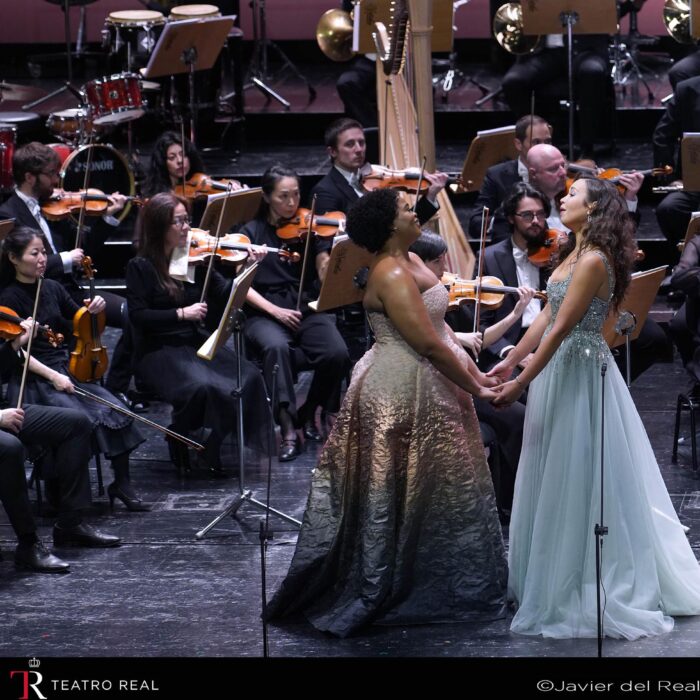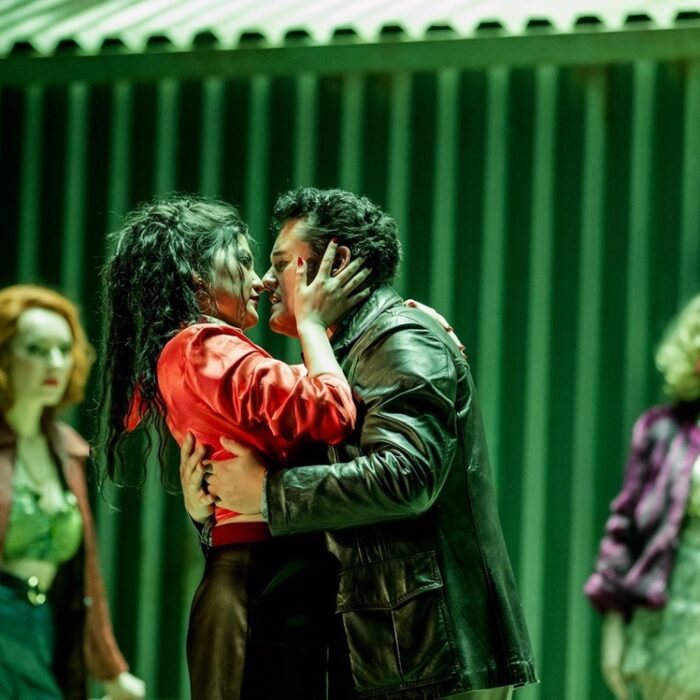
Brooklyn Art Song Society 2023-24 Review: Circles IV – Les Six
By Jennifer Pyron(Photo: Catherine Hancock)
Brooklyn Art Song Society (BASS) presented “Circles IV: Les Six” on Friday, January 5th 2024, at First Unitarian Church of Brooklyn. The compositions chosen for the evening were delightful examples of what made Les Six exciting, however short-lived the group proved to be.
Les Six was a peculiar group consisting of Georges Auric, Louis Durey, Arthur Honegger, Darius Milhaud, Francis Poulenc, and Germaine Tailleferre. Despite many theaters and performance halls remaining closed because of the First World War, Paris in 1917 was a fascinating time for art and musical collaborations. One of the founding members of Les Six, French composer Erik Satie, had a vision for a new group he called “Les nouveaux jeunes” while he and other artists attended art salon performances featuring music by Satie, Honnegger, Auric, and Durey: the beginning members of Les Six.
Jean Cocteau was also a prominent organizer of Les Six. His work in film made him an especially interesting, boundary pushing addition that led the way forward for more experimental inspiration. The compositions of Les Six as featured in the BASS’ “Circles IV: Les Six” series are great examples of Cocteau’s influence and the members who made Les Six an innovative enigma.
Georges Auric: Alphabet (1924)
“Georges Auric is perhaps the most underrated of the members of Les Six. His reputation has suffered as he spent much of his later career as a composer of film scores, which caused some to consider him a commercial rather than a ‘serious’ composer. However, Auric excelled in this field and was nominated for numerous Academy Awards. His concert music is as accomplished, if less recognized. ‘Alphabet’ (1924) is an earlier work, and bears the distinct mark of Jean Cocteau’s influence. The strikingly miniature songs (all seven can be performed in about five minutes) are based on surrealist poems by Raymond Radiguet (1903-1920), a scandalous figure from Cocteau’s circle, known for his semi-pornographic novel ‘Le Diable au corps’ (The Devil in the Flesh),” noted the artistic director of BASS, Michael Brofman.
Soprano Amy Owens and pianist Miori Sugiyama opened the evening’s performances with Auric’s “Alphabet” with impressive gusto. Owens’ voice in song one, “A-lbum,” sounded light and buoyant. The particular phrase, “Ayez grand soin de cet album né du plus funeste délire,” “be very careful with this album born of disastrous delirium,” came across as uncontrived, which reassured listeners of Owens’ particular level of awareness towards this song cycle.
Owens joyfully delivered wit with purpose. This being said, starting the evening of performances in this way was crucial. Les Six was an exclusive group of very accomplished artists. What came from each of them, however, especially during this time in history, greatly impacted a very broad interpretation of wit’s power in the creative period between the First and Second World Wars. The ability to still think for oneself, and create from this place of insatiable wit, was a cherished gift among most artists. This purpose remained at the forefront of works to come, especially from members of Les Six.
Song two, “B-ateau,” “A Boat,” was performed with precision and care, especially in Sugiyama’s piano playing. Song three, “D-omino,” “Dominoes,” felt like a blossoming moment where Owens’ voice fully came to life. The phrase, “Le domino, jeu des ménages,” “Dominoes, a household game,” sounded rich and colorful in her soprano. The remaining songs of the cycle, “F-ilet à papillons,” “M-allarmé,” “H-irondelle,” and “E-scarpin,” were also enjoyable and entertaining.
Owens’ voice and Sugiyama’s piano were a special combination of energetic flair.
Arthur Honegger: Trois Chansons de “La petite sirène” (1926)
Mezzo soprano Anna Laurenzo and Michael Brofman on piano, performed “The Little Mermaid” song cycle with magic and mystery. The opening piano phrase alone is always transportive and surreal. Laurenzo’s voice was exquisite as she sang, “Dans le vent et dans le flot dissous toi fragile écume dissous toi dans un sanglot,” “In the wind and in the waves, dissolve, fragile foam, dissolve in a sob.” Her eyes peered into the audience with a want for something so much more. She was the little mermaid, indeed.
Song two, “Berceuse de la sirène,” “The Siren’s Lullaby,” was performed with serene beauty by Laurenzo. Her middle voice sounded warm and round as she lulled listeners further into the little mermaid’s dreams. Song three, “Chanson de la poire,” “The Song of the Pear,” felt extra thrilling following song two’s sweet stillness. Laurenzo’s voice was bright and precise as she described the ways of a “pear.”
This song cycle’s librettist, the Swiss writer René Morax, has an interesting list of works if one wants to delve further into his comedies.
Louis Durey: Trois Poèmes de Pétrone (1918)
“Another of the more obscure members of Les Six, Louis Durey’s legacy was also marred by accusations of abandoning pure ‘concert’ music. This is because Durey was a lifelong Communist, and dedicated much of his later career to writing Marxist-themed odes and worker’s choruses. Political themes overwhelm much of works (BASS gave the American premiere of his ‘Two Poems of Ho Chi Minh’ in 2014). However, his earlier works, many in a neoclassical style, are quite appealing, as evidenced by the ‘Trois Poèmes de Pétrone’ (1918). Based on a Latin text in translation, Durey builds his musical language on small, insistent, repeating blocks. This was a common device for early Les Six works, meant to be a musical equivalent to Cubism in painting,” noted Brofman.
Anna Laurenzo’s voice glittered in a brilliant display of colors as she sang song one, “La boule de neige,” “The Snowball.” Her top notes were awe-inspiring, especially as she sang, “Julie, tu peux éteindre cependant l’ardeur qui me consume,” “But Julia, you can quench the fire that consumes me.” This might have been a favorite moment of the evening. Laurenzo’s voice was full of life!
Song two, “La Métempsychose,” “Transmigration of the Soul,” might also be another favorite. There was an undeniable mix of solace and divination that made the hairs of one’s head stand up straight. Louis Durey’s “pure” Les Six style is haunting. Laurenzo’s mezzo illuminated the complexity of thought and nuance to his composition very well. The phrase “haleine,mon âme, enivrée, se précipita sur mes lèvres, et, s’insinuant entre les siennes, s’efforçat de m’échapper,” “my soul, intoxicated, rushed up to my lips, and sneaked between his, trying escape from me,” sounded otherworldly in Laurenzo’s voice.
Song three, “La grenade,” “The Pomegranate,” was transcendent as Laurenzo sang and Brofman played the piano’s delightful fourths. It was an uplifting close to a truly transformative trio of songs.
Germaine Tailleferre: Six Chansons Françaises (1930)
“Germaine Tailleferre was the sole female member of Les Six, and the first female composer to be financially independent working as such. She was encouraged by Maurice Ravel, and highly prolific in the 1920s and ’30s in nearly every genre. These ‘Six Chansons Françaises’ (1930) are based on mostly anonymous texts from the 15th through the 18th century (one is a text by Voltaire). The work is unique in being primarily texts by women, set to music by a woman: a completely female perspective all too rare in music. The songs are in turn feisty, witty, and touching, and leave a lasting impression,” noted Brofman.
Soprano Sara LeMesh and pianist Miori Sugiyama were the perfect combination of female power for Germaine Tailleferre’s “Six Chansons Françaises.” LeMesh’s voice sounded divine as she sang song one, “Non, la fidélité,” “No Fidelity,” and especially as she indulged in the phrase “J’ai quitté par légèreté plus d’une beauté, vive la nouveauté!,” “Capriciously, I’ve left more than one beautiful woman. Long live novelty!”
Miori Sugiyama’s piano playing felt enlivened and engaged as LeMesh sang. This was a great combination. Song two, “Souvent un air de verité,” “Often an air of truth,” has text by Voltaire. In this, LeMesh’s voice epitomizes French music of this time. She sounded effortless as she glided through Tailleferre’s thoughtful details to accompany Voltaire’s empathetic text. In song three, “Mon mari m’a diffamée,” “My Husband Vilified Me,” LeMesh’s vocal agility was put to the test. Her French diction was crisp and her voice sounded full bodied. One could tell she had rehearsed this one a great deal, as it moved along quickly and had a lot of tongue-tying text!
The final song of this cycle, “Les trois présents,” “The Three Presents,” sounded glorious in LeMesh’s soprano. The high notes sparkled into the hall of the church and again, Voltaire’s text left a meaningful atmosphere lingering. LeMesh sang the phrase, “Je vous donne, avec grand plaisir, de trois présents un à choisir,” “I offer you, with great pleasure, three presents, for you to choose one,” with moments of pianissimo that would melt anyone’s heart.
Darius Milhaud: Chansons de Ronsard Op. 223 (1941)
“Darius Milhaud was the most prolific member of Les Six, with well over 400 opus numbers to his name, some of those being complete operas. His style was eclectic through his career, and his influences include neoclassicism, Jazz, South American folk music, and his own Jewish heritage. He was particularly interested in bitonality, a technique he employed in nearly all his stylistic efforts. He was also a beloved teacher at Mills College in California, and his many notable students include Dave Brubeck and Philip Glass. The ‘Chansons de Ronsard Op. 223’ is a virtuosic piece for coloratura soprano. Though the piece is better known in its orchestral version, Milhaud himself made the reduction, which is today performed just as frequently,” noted Brofman.
Soprano Amy Owens and pianist Miori Sugiyama performed Milhaud’s “Chansons de Ronsard Op. 223” together in stride. The high A’s that Owens’ soprano was expected to repeat throughout this piece sounded easy, but only because of Owens’ very disciplined vocal technique. Her throat remained open and her larynx relaxed, as the notes would jump into her highest registers at the drop of a hat. Owens also showed excellent stage presence and this made Milhaud’s challenging melodies appear much lighter and brighter. In the pre-lecture before this series’ performances began, Brofman mentioned how the Queen of the Night would be jealous of all these high notes.
The most striking parts of this song cycle were revealed when reading the text, written by French poet Pierre de Ronsard, while listening. This gave a better understanding of how masterful Milhaud was at narrating emotions and landscapes of the imagination. This song cycle highlights his gift for illustrating, through his compositions, the dream-world of his own mind. This was definitely a highlight in the series to behold and the audience applauded enthusiastically because of it. Amy Owens sounded incredible!
Francis Poulenc: Fiançailles pour rire (1939)
Sara LeMesh singing Poulenc’s “Fiançailles pour rire” was absolutely breathtaking. Her vocal dynamism and sonorous timbre filled the hall with an aura of sound. This was perfect for Poulenc’s song cycle too, because it hints at the ethereal details of Louise de Vilmorin’s poems. Brofman explained it best as he noted, “Vilmorin was a poet and novelist who was known for her exploration of the inner world of the French aristocracy. Poulenc was a dear friend of Vermilion and admired her poetry.”
All throughout this song cycle, moments of admiration arose that could be felt and heard especially-well in LeMesh’s voice. Song two, “Dans l’herbe,” “In the grass,” highlighted LeMesh’s upper register in pianissimo, especially as she sang, “Il est mort de sa belle, Il est mort de sa mort belle Dehors,” “He died of his beautiful one, he died of her beautiful death outside.” The following phrase, “Il est mort inaperçu en criant son passage en appelant en m’appelant,” “He died unnoticed shouting out his passage calling out calling out for me,” was another example of Poulenc’s sensuous word-painting with de Vilmorin’s text. LeMesh delivered each climax with grace and great understanding of this music’s deep emotional intelligence.
Francis Poulenc: Tel jour, telle nuit (1937)
Poulenc’s “Tel jour, telle nuit” is incredibly gorgeous and it was a pleasure to hear baritone Michael Kelly, and Michael Brofman on piano, bringing this work to life. The dark and serious tones that pour out of this work are profoundly moving, especially when setting the tone for Paul Éluard’s poems.
“Bonne journée” began with Kelly’s voice at a mezza voce so as to not disturb the melodic line. He continued to ease into the flow of Brofman’s piano and relied on the emotions of Éluard’s text to guide him. This was a perfect way to begin.
“Une ruine coquille vide” sounded round and warm in Kelly’s voice. His pianissimos were heart-wrenching. Brofman’s piano was a haunting interpretation, especially as he played after the ending phrase “Des folâtres lueurs nocturnes qui contredisent le sommeil,” “of the flitting nocturnal glimmerings which counter sleep.”
“Le front comme un drapeau perdu” illuminated Kelly’s middle range and lyric baritone. Instead of overly dramatizing this song, he leaned into the quiet underlining of reflection in Éluard’s text. The phrase “Une nappe d’eau près des seins où se noyer comme une pierre,” “a water table near the breasts in which to drown like a stone,” was particularly soft and meaningful in Kelly’s tone.
“Une roulotte couverte en tuiles” was along the same line of expression in Kelly’s voice, and the phrase, “Comme deux poings,” “like two fists,” was extremely exciting. The tenderness of the closing line, “Ce mélodrame nous arrache La raison du cœur,” felt like a dream.
“A toutes brides” was in full motion as Brofman played the piano and Kelly’s voice was bright and expressive. “Cède au feu qui te désespère” was an illuminating phrase as Kelly sang with clarity and precision.
“Une herbe pauvre” highlighted Kelly’s vocal technique as he maneuvered through pianissimi and mezza voce very well. There was power in his softness of approach. This also set him up well for the next song, “Je n’ai envie que de t’aimer,” where his voice sounded refreshed and full of life. Kelly summoned a necessary new flow of energy here that put him in a solid place to finish out the remainder of the song cycle. It is always so inspiring when singers feel this level of revitalized energy kick in and go to work just when they know they will need it.
“Figure de force brûlante et farouche,” “Face of wild and burning strength,” was an impressive moment when Kelly’s voice really stretched into its power. The final phrase, “Cette santé bâtit une prison,” however, sounded like he may have timed his breath a little off, because the placement of the last note was not quite in alignment with what his voice is normally capable of executing with ease.
The final song, “Nous avons fait la nuit,” was sonorous and sensual in Kelly’s voice. His interpretation of Poulenc’s “Tel jour, telle nuit” as a whole was the perfect close to an exciting start for the new year with BASS.
One can look forward to the next BASS series, “Circles V: The Minnesota Connection,” on Friday, February 2, 2024.



